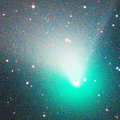
|
It approached to Earth down to 0.29 a.u. in early February, and it brightened up to 4.5 mag (Feb. 1, Juan Jose Gonzalez). Now it is fading. But it is still very bright as 8.0 mag (Feb. 23, Osamu Miyazaki). In the Northern Hemisphere, it stays observable until mid April. In the Southern Hemisphere, it stays observable in good condition after this.
Date(TT) R.A. (2000) Decl. Delta r Elong. m1 Best Time(A, h)
Feb. 25 4 38.08 4 4.5 0.817 1.311 92 7.7 19:15 ( 26, 56)
Mar. 4 4 38.92 -0 13.2 1.028 1.372 85 8.4 19:21 ( 35, 49)
|

|
Now it is very bright as 8.2 mag (Feb. 21, Marco Goiato). It is observable at 8 mag for a long time from 2022 to 2023. In the Southern Hemisphere, it stays observable for a long time. In the Northern Hemisphere, it is not observable until summer.
Date(TT) R.A. (2000) Decl. Delta r Elong. m1 Best Time(A, h)
Feb. 25 1 46.50 -60 24.7 2.243 1.990 62 8.0 19:15 ( 26,-16)
Mar. 4 2 18.66 -56 11.8 2.271 2.030 63 8.1 19:21 ( 29,-13)
|
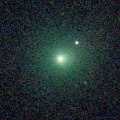
|
It brightened very rapidly. Now it is very bright as 10.3 mag (Feb. 23, Osamu Miyazaki). It stays 9-10 mag until March. In the Northern Hemisphere, it stays observable for a long time. But it locates low until spring. In the Southern Hemisphere, it is not observable until June.
Date(TT) R.A. (2000) Decl. Delta r Elong. m1 Best Time(A, h)
Feb. 25 22 10.30 52 41.0 1.962 1.738 62 9.8 5:11 (220, 22)
Mar. 4 22 37.66 50 33.9 2.065 1.745 57 9.9 5:02 (221, 19)
|
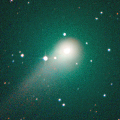
|
Now it is 10.6 mag (Feb. 23, Osamu Miyazaki). It stays bright as 10 mag for a long time until autumn. In the Northern Hemisphere, it becomes unobservable temporarily in early April. But it becomes observable again in summer. In the Southern Hemipshere, it stays unobservable until summer.
Date(TT) R.A. (2000) Decl. Delta r Elong. m1 Best Time(A, h)
Feb. 25 1 43.18 43 33.7 2.553 2.378 68 9.8 19:15 (119, 45)
Mar. 4 1 48.33 40 41.0 2.655 2.352 61 9.8 19:21 (117, 40)
|

|
Now it is 12.1 mag (Feb. 8, T. Prystavski). It is expected to brighten up to 10 mag from spring to summer. In the Southern Hemisphere, it stays observable in good condition for a long time. In the Northern Hemisphere, it is not observable until 2024 autumn.
Date(TT) R.A. (2000) Decl. Delta r Elong. m1 Best Time(A, h)
Feb. 25 19 27.90 -35 4.8 3.718 3.156 48 11.3 5:11 (315, 0)
Mar. 4 19 36.17 -36 38.8 3.611 3.141 54 11.2 5:02 (317, 1)
|

|
It brightened up to 8.3 mag in last winter (Jan. 6, 2022, Toshiyuki Takahashi). Now it is fading. But it is bright as 11.9 mag still now (Feb. 16, Chris Wyatt). It is observable in excellent condition in the Southern Hemisphere. It locates low in the Northern Hemisphere.
Date(TT) R.A. (2000) Decl. Delta r Elong. m1 Best Time(A, h)
Feb. 25 9 20.07 -35 14.5 4.355 5.075 132 11.8 22:59 ( 0, 20)
Mar. 4 9 15.54 -35 7.9 4.402 5.117 131 11.9 22:27 ( 0, 20)
|
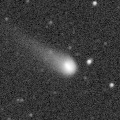
|
Now it is 12.1 mag (Feb. 21, Osamu Miyazaki). It stays 12 mag until summer. It stays observable in good condition for a long time.
Date(TT) R.A. (2000) Decl. Delta r Elong. m1 Best Time(A, h)
Feb. 25 13 2.90 -0 7.0 2.814 3.636 140 11.9 2:47 ( 0, 55)
Mar. 4 12 50.18 -0 27.4 2.734 3.632 150 11.8 2:07 ( 0, 54)
|
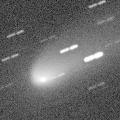
|
Now it is 12.1 mag (Feb. 20, Osamu Miyazaki). It stays 11-12 mag until spring.
Date(TT) R.A. (2000) Decl. Delta r Elong. m1 Best Time(A, h)
Feb. 25 16 46.85 -18 45.6 1.561 1.745 83 12.0 5:11 (338, 33)
Mar. 4 17 0.24 -18 57.0 1.524 1.773 86 12.1 5:02 (339, 33)
|
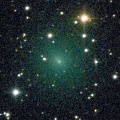
|
It brightened very rapidly up to 9.6 mag in late January (Jan. 25, Toshihiko Ikemura, Hirohisa Sato). It is still bright as 12.5 mag (Feb. 23, Osamu Miyazaki). It stays observable in good condition for a long time. But it will be fading after this.
Date(TT) R.A. (2000) Decl. Delta r Elong. m1 Best Time(A, h)
Feb. 25 5 51.11 18 34.8 0.769 1.463 112 12.1 19:33 ( 0, 73)
Mar. 4 6 5.23 12 25.0 0.869 1.508 108 12.7 19:21 ( 1, 67)
|
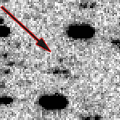
|
It approached to Sun down to 0.1 a.u. on Jan. 31. Appearing in the morning sky. It was bright as 7.0-7.5 mag in early February (Feb. 5, Michael Jager). Now it is fading rapidly. It has already faded down to 12.1 mag (Feb. 20, M. G. J. Breukers, N. Paul). It stays observable after this while the comet will be fading.
Date(TT) R.A. (2000) Decl. Delta r Elong. m1 Best Time(A, h)
Feb. 25 20 11.89 -6 53.6 1.399 0.806 34 12.3 5:11 (287, 11)
Mar. 4 20 14.45 -7 13.2 1.472 0.960 40 13.3 5:02 (290, 14)
|
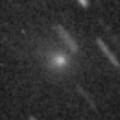
|
Bright new comet. Now it is 12.7 mag (Feb. 13, M. Mattiazzo). In the Southern Hemisphere, it stays observable in good condition after this. In the Northern Hemisphere, it is not observable after this.
Date(TT) R.A. (2000) Decl. Delta r Elong. m1 Best Time(A, h)
Feb. 25 20 26.23 -25 38.4 1.815 1.132 33 12.8 5:11 (299, -3)
Mar. 4 20 42.14 -29 57.0 1.793 1.201 39 13.1 5:02 (303, -5)
|
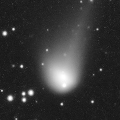
|
Now it is bright as 12.9 mag (Feb. 24, Toshihiko Ikemura, Hirohisa Sato). It stays 13 mag until spring. It stays observable in good condition for a while after this.
Date(TT) R.A. (2000) Decl. Delta r Elong. m1 Best Time(A, h)
Feb. 25 15 41.22 6 23.9 4.434 4.757 103 12.9 5:11 (353, 61)
Mar. 4 15 43.07 7 38.5 4.367 4.783 109 12.9 4:58 ( 0, 63)
|
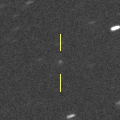
|
It brightens up to 13 mag in winter. But the condition is bad. Appearing in the morning sky in the Southern Hemisphere. It is not observable until May in the Northern Hemisphere.
Date(TT) R.A. (2000) Decl. Delta r Elong. m1 Best Time(A, h)
Feb. 25 20 37.59 -23 28.2 2.395 1.620 30 13.1 5:11 (296, -4)
Mar. 4 20 58.94 -22 28.4 2.382 1.634 32 13.1 5:02 (295, -3)
|
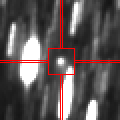
|
Now it is 14.4 mag (Feb. 17, Jean-Claude Merlin). It will brighten very rapidly. It is expected to be observable at 11 mag in excellent condition from spring to summer.
Date(TT) R.A. (2000) Decl. Delta r Elong. m1 Best Time(A, h)
Feb. 25 17 39.34 -24 55.7 2.194 2.084 70 13.6 5:11 (328, 22)
Mar. 4 17 54.67 -24 25.1 2.107 2.068 74 13.3 5:02 (328, 23)
|
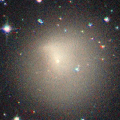
|
It brightened in major outburst in late November. Now it is still bright as 11.6 mag (Feb. 16, Toshihiko Ikemura, Hirohisa Sato).
Date(TT) R.A. (2000) Decl. Delta r Elong. m1 Best Time(A, h)
Feb. 25 6 16.79 28 36.4 5.550 6.075 117 13.6 19:58 ( 0, 84)
Mar. 4 6 16.60 28 26.6 5.654 6.077 110 13.6 19:30 ( 0, 83)
|
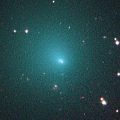
|
Now it is bright as 11.4 mag (Dec. 14, Jose Guilherme de S. Aguiar). It will be fading after this. In the Southern Hemisphere, it stays observable in good condition for a long time, although it became unobservable temporarily from December to January. In the Northern Hemisphere, it is not observable until spring when it fades down to 15 mag.
Date(TT) R.A. (2000) Decl. Delta r Elong. m1 Best Time(A, h)
Feb. 25 19 16.38 -39 44.5 2.389 1.954 52 13.6 5:11 (320, -1)
Mar. 4 19 10.95 -40 23.7 2.300 2.004 60 13.9 5:02 (324, 1)
|

|
Now it is 13.8 mag (Feb. 15, Toshihiko Ikemura, Hirohisa Sato). The brightness evolution is slower than originally predicted. It stays 14 mag until summer. In the Northern Hemisphere, it will too low to observe in late March. In the Southern Hemisphere, it stays observable in good condition for a long time.
Date(TT) R.A. (2000) Decl. Delta r Elong. m1 Best Time(A, h)
Feb. 25 3 22.17 -15 55.9 2.283 2.176 71 13.7 19:15 ( 37, 30)
Mar. 4 3 26.92 -16 48.2 2.339 2.147 66 13.7 19:21 ( 43, 26)
|
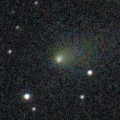
|
Now it is 13.3 mag (Feb. 15, Toshihiko Ikemura, Hirohisa Sato). It will be fading after this. It stays observable in good condition for a while.
Date(TT) R.A. (2000) Decl. Delta r Elong. m1 Best Time(A, h)
Feb. 25 8 22.96 18 21.1 1.080 1.989 147 13.7 22:03 ( 0, 73)
Mar. 4 8 23.76 19 14.6 1.143 2.012 140 14.0 21:37 ( 0, 74)
|
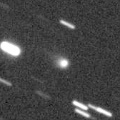
|
Now it is 15.6 mag (Feb. 8, A. Diepvens). It is expected to brighten up to 8 mag in July. It will be unobservable soon. In the Southern Hemisphere, it will be observable in excellent condition at the high light. In the Northern Hemisphere, it becomes very low at the high lihght.
Date(TT) R.A. (2000) Decl. Delta r Elong. m1 Best Time(A, h)
Feb. 25 0 22.40 -12 11.9 3.389 2.554 27 14.2 19:15 ( 73, 3)
Mar. 4 0 23.51 -11 54.3 3.376 2.485 22 14.1 19:21 ( 78, -4)
|
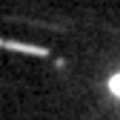
|
Now it is 14.9 mag (Feb. 10, ATLAS South Africa). It will brighten rapidly up to 14 mag and will be observable in excellent condition in spring. In the Northern Hemisphere, it is observable in good condition in winter, but it becomes somewhat low in spring.
Date(TT) R.A. (2000) Decl. Delta r Elong. m1 Best Time(A, h)
Feb. 25 14 34.01 -17 57.0 1.780 2.362 113 14.6 4:17 ( 0, 37)
Mar. 4 14 35.55 -19 31.4 1.699 2.357 120 14.5 3:51 ( 0, 35)
|
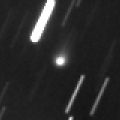
|
Now it is 14.1 mag (Feb. 15, Toshihiko Ikemura, Hirohisa Sato). It stays 14 mag in 2023. In the Southern Hemisphere, it stays observable in good condition for a long time, although it becomes unobservable temporarily from April to May. It locates somewhat low in the Northern Hemisphere.
Date(TT) R.A. (2000) Decl. Delta r Elong. m1 Best Time(A, h)
Feb. 25 2 38.38 -10 49.0 3.716 3.349 60 14.6 19:15 ( 51, 28)
Mar. 4 2 36.10 -9 27.7 3.812 3.333 54 14.6 19:21 ( 59, 23)
|
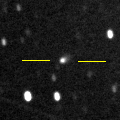
|
Now it is 14.9 mag (Feb. 18, ATLAS South Africa). It is expected to brighten up to 7 mag in early 2024. In the Southern Hemisphere, it stays observable in good condition for a long time. It locates low in the Northern Hemisphere.
Date(TT) R.A. (2000) Decl. Delta r Elong. m1 Best Time(A, h)
Feb. 25 5 13.38 -34 38.2 4.390 4.556 93 14.8 19:15 ( 5, 20)
Mar. 4 5 13.20 -33 42.6 4.384 4.489 89 14.7 19:21 ( 12, 20)
|
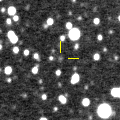
|
Now it is 15.5 mag (Feb. 13, ATLAS Chile). It will brighten up to 13 mag from 2024 to 2025. It is observable in excllent condition in the Southern Hemisphere. It locates low in the Northern Hemisphere.
Date(TT) R.A. (2000) Decl. Delta r Elong. m1 Best Time(A, h)
Feb. 25 8 51.05 -38 41.7 5.891 6.530 126 14.9 22:31 ( 0, 16)
Mar. 4 8 48.66 -38 12.8 5.864 6.498 126 14.9 22:01 ( 0, 17)
|

|
Now it is 15.4 mag (Feb. 24, Toshihiko Ikemura, Hirohisa Sato). The brightness evolution is slower than originally expected. It stays 14-15 mag for a long time. It stays observable in good condition for a while.
Date(TT) R.A. (2000) Decl. Delta r Elong. m1 Best Time(A, h)
Feb. 25 18 8.81 0 4.9 3.644 3.361 65 15.0 5:11 (304, 39)
Mar. 4 18 9.43 2 7.8 3.563 3.394 72 14.9 5:02 (307, 43)
|
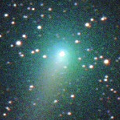
|
It brightened up to 9.3 mag in early summer in 2022 (June 5, Chris Wyatt). Now it is fading. It has already faded down to 15.7 mag (Feb. 15, Toshihiko Ikemura, Hirohisa Sato). In the Southen Hemisphere, it stays observable in good condition for a long time. It locates somewhat low in the Northern Hemisphere.
Date(TT) R.A. (2000) Decl. Delta r Elong. m1 Best Time(A, h)
Feb. 25 6 53.71 -24 2.8 2.974 3.541 117 15.3 20:33 ( 0, 31)
Mar. 4 6 48.48 -21 18.9 3.100 3.605 113 15.5 20:01 ( 0, 34)
|

|
Now it is 14.8 mag (Dec. 8, ATLAS Chile). Now it is not observable. It will become observable again in late March in the Southern Hemisphere, or in late May in the Northern Hemisphere.
Date(TT) R.A. (2000) Decl. Delta r Elong. m1 Best Time(A, h)
Feb. 25 22 17.74 -17 45.5 4.218 3.243 8 15.3 5:11 (278,-20)
Mar. 4 22 27.98 -16 49.7 4.217 3.255 12 15.4 5:02 (278,-18)
|
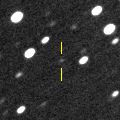
|
Now it is 15.4 mag (Feb. 17, Toshihiko Ikemura, Hirohisa Sato). It is expected to brighten up to 12-13 mag from 2024 to 2025.
Date(TT) R.A. (2000) Decl. Delta r Elong. m1 Best Time(A, h)
Feb. 25 9 39.26 -15 47.1 5.167 6.057 151 15.9 23:19 ( 0, 39)
Mar. 4 9 32.80 -14 44.7 5.134 6.014 150 15.8 22:45 ( 0, 40)
|
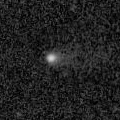
|
Now it is 14.6 mag (Feb. 15, Toshihiko Ikemura, Hirohisa Sato). It stays 15-16 mag and observable in good condition until spring. It is brighter than this ephemeris recently.
Date(TT) R.A. (2000) Decl. Delta r Elong. m1 Best Time(A, h)
Feb. 25 9 24.06 27 28.9 2.444 3.373 156 15.9 23:04 ( 0, 82)
Mar. 4 9 22.38 28 8.0 2.487 3.376 149 16.0 22:35 ( 0, 83)
|
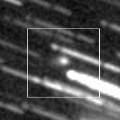
|
Now it is 16.2 mag (Feb. 21, Toshihiko Ikemura, Hirohisa Sato). It is expected to brighten up to 11.5 mag in 2024 spring. It stays observable in good condition for a long time. Appearing in the morning sky also in the Southern Hemisphere. At the high light, it will be observable in excellent condition in the Southern Hemisphere, but it will be low in the Northern Hemisphere.
Date(TT) R.A. (2000) Decl. Delta r Elong. m1 Best Time(A, h)
Feb. 25 18 36.37 15 36.0 4.990 4.627 63 16.1 5:11 (282, 44)
Mar. 4 18 37.17 16 3.1 4.852 4.576 68 16.0 5:02 (285, 48)
|
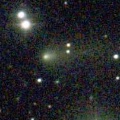
|
Now it is 14.7 mag (Feb. 16, Toshihiko Ikemura, Hirohisa Sato). It will be fading after this, and it will be fainter than 18 mag in spring. It is observable in good condition in the Northern Hemisphere. It locates somewhat low in the Southern Hemisphere. It is brighter than this ephemeris recently.
Date(TT) R.A. (2000) Decl. Delta r Elong. m1 Best Time(A, h)
Feb. 25 7 25.70 25 38.3 1.906 2.684 133 16.1 21:06 ( 0, 81)
Mar. 4 7 26.22 25 45.8 1.997 2.706 126 16.3 20:39 ( 0, 81)
|
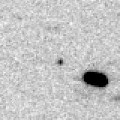
|
Now it is 15.6 mag (Feb. 17, Toshihiko Ikemura, Hirohisa Sato). It stays observable at 16 mag for a long time from early 2023 to early 2024. In the Northern Hemisphere, it is observable only until 2023 spring.
Date(TT) R.A. (2000) Decl. Delta r Elong. m1 Best Time(A, h)
Feb. 25 9 13.91 -5 36.8 3.243 4.165 155 16.3 22:53 ( 0, 49)
Mar. 4 9 4.48 -6 6.2 3.255 4.138 149 16.2 22:16 ( 0, 49)
|

|
It was observed at 15 mag from 2021 to 2022. Now it is fading. Now it is 16.3 mag (Feb. 11, J.-C. Merlin, D. De Martin). In the Southern Hemisphere, it stays observable in excellent condition for a long time. In the Northern Hemiphere, it is not observable after this.
Date(TT) R.A. (2000) Decl. Delta r Elong. m1 Best Time(A, h)
Feb. 25 15 1.22 -69 11.2 6.105 6.165 88 16.3 4:45 ( 0,-14)
Mar. 4 14 51.35 -70 21.5 6.053 6.195 93 16.3 4:08 ( 0,-15)
|
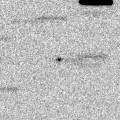
|
Now it is 16.4 mag (Feb. 21, Toshihiko Ikemura, Hirohisa Sato). It is observable at 16.5 mag in good condition from January to March. It locates somewhat low in the Southern Hemisphere.
Date(TT) R.A. (2000) Decl. Delta r Elong. m1 Best Time(A, h)
Feb. 25 13 24.07 30 24.1 0.365 1.273 134 16.4 3:07 ( 0, 85)
Mar. 4 13 32.10 31 0.6 0.382 1.295 136 16.4 2:47 ( 0, 86)
|

|
Now it is 15.8 mag (Feb. 7, ATLAS Chile). It was expected to brighten up to 13 mag in 2022 spring. But actually, it was fainter than originally expected. In the Southern Hemisphere, it stays observable in good condition for a long time, although it becomes unobservable temporarily from April to May. In the Northern Hemisphere, it will be unobservable in March.
Date(TT) R.A. (2000) Decl. Delta r Elong. m1 Best Time(A, h)
Feb. 25 2 14.86 -22 57.2 4.423 3.943 55 16.4 19:15 ( 47, 15)
Mar. 4 2 16.60 -21 8.4 4.541 3.982 50 16.5 19:21 ( 54, 12)
|
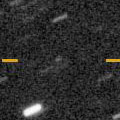
|
Appearing in the morning sky. It stays observable at 14-15 mag from spring to autumn. It locates somewhat low in the Northern Hemisphere.
Date(TT) R.A. (2000) Decl. Delta r Elong. m1 Best Time(A, h)
Feb. 25 17 43.61 -13 18.7 3.326 3.132 70 16.5 5:11 (320, 32)
Mar. 4 17 51.70 -13 37.6 3.218 3.115 75 16.4 5:02 (323, 33)
|
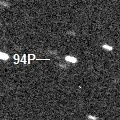
|
Now it is 16.6 mag (Feb. 21, ATLAS Chile). It is observable at 16.5 mag in good condition in spring. It locates somewhat low in the Southern Hemisphere.
Date(TT) R.A. (2000) Decl. Delta r Elong. m1 Best Time(A, h)
Feb. 25 8 15.17 28 57.1 1.436 2.303 142 16.5 21:55 ( 0, 84)
Mar. 4 8 13.33 28 55.1 1.476 2.292 135 16.5 21:26 ( 0, 84)
|
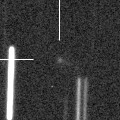
|
Now it is 16.8 mag (Feb. 11, Giuseppe Pappa). It will brighten up to 13 mag in summer. In the Northern Hemisphere, it stays observable in good condition for a long time. In the Southern Hemisphere, it is not observable until August.
Date(TT) R.A. (2000) Decl. Delta r Elong. m1 Best Time(A, h)
Feb. 25 4 37.32 78 48.2 1.751 2.149 99 16.5 19:15 (176, 46)
Mar. 4 3 36.43 76 31.7 1.796 2.081 91 16.5 19:21 (168, 45)
|
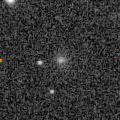
|
Now it is 16.2 mag (Feb. 16, Toshihiko Ikemura, Hirohisa Sato). It moves along an almost circular orbit. It seems to be bright temporarily in outburst.
Date(TT) R.A. (2000) Decl. Delta r Elong. m1 Best Time(A, h)
Feb. 25 10 54.71 25 16.3 5.189 6.143 163 16.5 0:39 ( 0, 80)
Mar. 4 10 51.60 25 35.1 5.196 6.142 161 16.5 0:08 ( 0, 80)
|
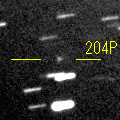
|
It brightened rapidly. Now it is 16.7 mag (Feb. 16, Toshihiko Ikemura, Hirohisa Sato). It will be fading after this. It will be fainter than 18 mag in April.
Date(TT) R.A. (2000) Decl. Delta r Elong. m1 Best Time(A, h)
Feb. 25 10 0.40 21 13.6 1.056 2.031 166 16.5 23:40 ( 0, 76)
Mar. 4 9 56.76 21 45.0 1.100 2.057 159 16.7 23:09 ( 0, 77)
|
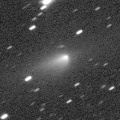
|
It brightened up to 12.7 mag in last year (Feb. 27, 2022, Jose Guilherme de S. Aguiar). Now it is fading. Appearing in the morning sky. In the Southern Hemisphere, it stays observable until summer when it becomes fainter than 18 mag. It locates low in the Northern Hemisphere.
Date(TT) R.A. (2000) Decl. Delta r Elong. m1 Best Time(A, h)
Feb. 25 18 48.80 -25 42.5 3.102 2.659 54 16.6 5:11 (315, 13)
Mar. 4 18 59.90 -25 35.4 3.049 2.683 59 16.6 5:02 (316, 14)
|
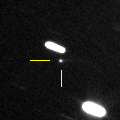
|
Now it is 17.2 mag (Feb. 21, Toshihiko Ikemura, Hirohisa Sato). It will brighten very rapidly up to 11.5 mag in April. In the Southern Hemisphere, it stays observable in good condition for a long time. In the Northern Hemisphere, it is not observable from mid April to mid June.
Date(TT) R.A. (2000) Decl. Delta r Elong. m1 Best Time(A, h)
Feb. 25 13 31.94 21 58.2 0.524 1.409 134 17.1 3:15 ( 0, 77)
Mar. 4 13 48.49 23 35.3 0.433 1.335 135 16.6 3:03 ( 0, 78)
|
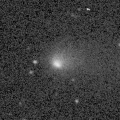
|
It brightened up to 14.6 mag in autumn (Oct. 19, Toshihiko Ikemura, Hirohisa Sato). Now it is fading. It has already faded down to 17.6 mag (Feb. 16, Toshihiko Ikemura, Hirohisa Sato). It will be fainter than 18 mag in spring.
Date(TT) R.A. (2000) Decl. Delta r Elong. m1 Best Time(A, h)
Feb. 25 2 57.99 11 2.7 2.474 2.323 69 16.7 19:15 ( 66, 47)
Mar. 4 3 9.90 12 2.7 2.571 2.344 65 16.9 19:21 ( 72, 44)
|
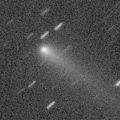
|
It brightened up to 14.1 mag in autumn (Nov. 14, Thomas Lehmann). Now it is fading. It has already faded down to 16.3 mag (Feb. 16, Toshihiko Ikemura, Hirohisa Sato). In the Northern Hemisphere, it stays observable in excellent condition for a while. In the Southern Hemisphere, it will be unobservable soon.
Date(TT) R.A. (2000) Decl. Delta r Elong. m1 Best Time(A, h)
Feb. 25 3 3.40 33 29.9 2.655 2.627 77 16.8 19:15 ( 98, 59)
Mar. 4 3 14.88 34 12.4 2.759 2.651 73 16.9 19:21 (102, 55)
|
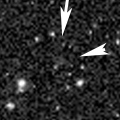
|
Now it is 16.6 mag (Feb. 9, ATLAS Chile). Very far object. It stays 16-17 mag for a long time from 2021 to 2026. In the Southern Hemisphere, it stays observable in good condition for a long time. In the Northern Hemisphere, it is not observable at all.
Date(TT) R.A. (2000) Decl. Delta r Elong. m1 Best Time(A, h)
Feb. 25 5 10.71 -73 55.0 10.470 10.409 83 16.9 19:15 ( 2,-19)
Mar. 4 5 5.08 -73 15.9 10.458 10.404 84 16.9 19:21 ( 5,-19)
|
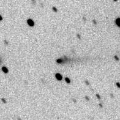
|
Now it is 16.4 mag (Feb. 17, Toshihiko Ikemura, Hirohisa Sato). It will be fading and getting lower gradually after this. It will be unobservable in April in the Northern Hemisphere, or in May in the Southern Hemisphere.
Date(TT) R.A. (2000) Decl. Delta r Elong. m1 Best Time(A, h)
Feb. 25 4 14.24 2 14.6 3.455 3.534 86 16.9 19:15 ( 34, 52)
Mar. 4 4 19.19 2 52.0 3.556 3.540 81 17.0 19:21 ( 44, 49)
|
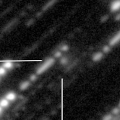
|
Now it is 17.2 mag (Feb. 8, J.-C. Merlin, D. De Martin). It brightens up to 16.5 mag from March to April. In the Southern Hemisphere, it stays observable in excellent condition. In the Northern Hemisphere, it is not observable until the end of March.
Date(TT) R.A. (2000) Decl. Delta r Elong. m1 Best Time(A, h)
Feb. 25 11 24.69 -56 33.4 1.108 1.751 113 17.2 1:08 ( 0, -2)
Mar. 4 11 31.84 -55 40.5 1.053 1.745 117 17.0 0:47 ( 0, -1)
|
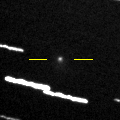
|
Now it is 16.5 mag (Feb. 23, Toshihiko Ikemura, Hirohisa Sato). In the Northern Hemisphere, it stays observable at 17 mag in excellent condition from February to March. In the Southern Hemisphere, it is not observable until late March.
Date(TT) R.A. (2000) Decl. Delta r Elong. m1 Best Time(A, h)
Feb. 25 10 34.86 73 28.8 1.195 1.855 115 17.1 0:25 (180, 51)
Mar. 4 8 58.31 68 25.5 1.189 1.844 115 17.0 22:06 (180, 57)
|
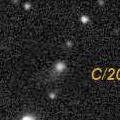
|
Now it is 17.0 mag (Feb. 24, Toshihiko Ikemura, Hirohisa Sato). It stays 17 mag and observable in good condition until summer.
Date(TT) R.A. (2000) Decl. Delta r Elong. m1 Best Time(A, h)
Feb. 25 13 20.23 8 20.8 8.152 8.913 138 17.1 3:04 ( 0, 63)
Mar. 4 13 16.49 8 57.3 8.086 8.919 145 17.0 2:32 ( 0, 64)
|

|
It will approach to Sun down to 0.8 a.u. in April, and it will brighten up to 15 mag. In the Southern Hemisphere, it stays observable in the extremely low sky. In the Northern Hemisphere, it is not observable after March.
Date(TT) R.A. (2000) Decl. Delta r Elong. m1 Best Time(A, h)
Feb. 25 19 40.36 -20 3.5 1.576 1.076 42 17.7 5:11 (302, 9)
Mar. 4 20 16.95 -18 51.0 1.535 1.015 40 17.1 5:02 (298, 7)
|
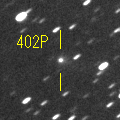
|
It brightened up to 15.3 mag in last winter (Jan. 12, 2022, H. Nohara). Now it is fading. It has already faded down to 17.3 mag (Feb. 16, Toshihiko Ikemura, Hirohisa Sato). It will be observable at 17 mag in good condition in next winter. It locates low in the Southern Hemisphere.
Date(TT) R.A. (2000) Decl. Delta r Elong. m1 Best Time(A, h)
Feb. 25 10 5.07 29 12.4 3.686 4.625 159 17.1 23:45 ( 0, 84)
Mar. 4 10 1.50 29 49.8 3.736 4.644 153 17.2 23:14 ( 0, 85)
|

|
It has not been observed yet in this apparition. In the last apparition, it had faded before the perihelion passage. If it becomes as bright as its last apparition, it will brighten up to 17 mag. It stays observable in good condition for a long time.
Date(TT) R.A. (2000) Decl. Delta r Elong. m1 Best Time(A, h)
Feb. 25 14 13.47 1 12.4 2.180 2.853 123 17.3 3:56 ( 0, 56)
Mar. 4 14 15.35 1 47.1 2.092 2.836 130 17.3 3:31 ( 0, 57)
|
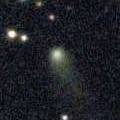
|
Now it is 17.1 mag (Feb. 24, Toshihiko Ikemura, Hirohisa Sato). Fading slowly. In the Southern Hemisphere, it is not observable after this.
Date(TT) R.A. (2000) Decl. Delta r Elong. m1 Best Time(A, h)
Feb. 25 18 24.61 48 1.2 6.262 6.147 78 17.3 5:11 (234, 55)
Mar. 4 18 30.38 49 14.5 6.270 6.180 80 17.4 5:02 (232, 57)
|
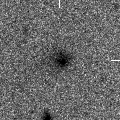
|
Now it is 17.8 mag (Feb. 1, ATLAS Chile). Very large comet. It is expected to brighten up to 14 mag in 2031. In the Southern Hemisphere, it stays observable in good condition for a long time. In the Northern Hemisphere, it is not observable until 2030.
Date(TT) R.A. (2000) Decl. Delta r Elong. m1 Best Time(A, h)
Feb. 25 2 31.32 -58 38.7 18.318 17.951 66 17.4 19:15 ( 22,-11)
Mar. 4 2 33.00 -58 23.4 18.305 17.926 66 17.3 19:21 ( 26,-14)
|

|
Now it is 17.2 mag (Feb. 13, D. Buczynski). Fading slowly. In the Northern Hemisphere, it stays observable in good condition for a long time. In the Southern Hemisphere, it is not observable after this.
Date(TT) R.A. (2000) Decl. Delta r Elong. m1 Best Time(A, h)
Feb. 25 18 28.53 69 9.4 9.710 9.740 88 17.4 5:11 (202, 48)
Mar. 4 18 30.94 70 4.2 9.731 9.757 88 17.4 5:02 (200, 49)
|

|
It brightened very rapidly up to 15.5 mag from last autumn to last winter (Nov. 2, 2021, Toshihiko Ikemura, Hirohisa Sato). Now it is fading slowly. It has already faded down to 16.7 mag (Feb. 17, Toshihiko Ikemura, Hirohisa Sato).
Date(TT) R.A. (2000) Decl. Delta r Elong. m1 Best Time(A, h)
Feb. 25 6 10.25 10 20.6 4.117 4.638 116 17.5 19:51 ( 0, 65)
Mar. 4 6 11.02 10 33.8 4.234 4.659 109 17.6 19:24 ( 0, 66)
|
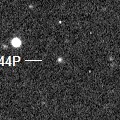
|
Now it is 17.6 mag (Feb. 17, Toshihiko Ikemura, Hirohisa Sato). It will be fading after this, and it will be fainter than 18 mag in April. It locates somewhat low in the Southern Hemisphere.
Date(TT) R.A. (2000) Decl. Delta r Elong. m1 Best Time(A, h)
Feb. 25 5 48.53 25 52.2 3.466 3.939 111 17.6 19:29 ( 0, 81)
Mar. 4 5 50.36 25 47.8 3.568 3.942 104 17.6 19:21 ( 23, 80)
|
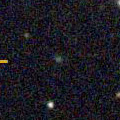
|
Now it is 17.4 mag (Feb. 16, Toshihiko Ikemura, Hirohisa Sato). It stays 17 mag for a long time from 2023 to 2024. It is observable in good condition in the Northern Hemisphere. It locates low in the Southern Hemisphere.
Date(TT) R.A. (2000) Decl. Delta r Elong. m1 Best Time(A, h)
Feb. 25 2 33.94 28 18.6 7.268 6.988 69 17.6 19:15 ( 93, 51)
Mar. 4 2 37.63 28 29.9 7.356 6.976 63 17.6 19:21 ( 97, 45)
|
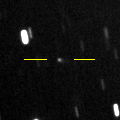
|
Now it is 17.2 mag (Feb. 21, Toshihiko Ikemura, Hirohisa Sato). In the Northern Hemisphere, it stays observable at 17.5 mag in good condition from spring to summer. In the Southern Hemisphere, it locates extremely low only in summer.
Date(TT) R.A. (2000) Decl. Delta r Elong. m1 Best Time(A, h)
Feb. 25 13 16.02 45 34.5 2.590 3.308 129 17.8 2:59 (180, 80)
Mar. 4 13 17.19 47 37.9 2.556 3.275 129 17.7 2:33 (180, 78)
|
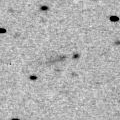
|
Now it is 18.5 mag (Feb. 21, Toshihiko Ikemura, Hirohisa Sato). It stays observable at 18 mag in good condition from January to March.
Date(TT) R.A. (2000) Decl. Delta r Elong. m1 Best Time(A, h)
Feb. 25 10 19.38 14 46.8 3.205 4.191 173 17.8 0:03 ( 0, 70)
Mar. 4 10 16.04 15 12.2 3.216 4.188 166 17.8 23:28 ( 0, 70)
|
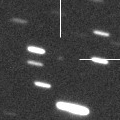
|
Now it is 18 mag (Feb. 11, Giuseppe Pappa). It stays 17.5 mag until spring. It is observable in good condition in the Northern Hemisphere. It is not observable in the Southern Hemisphere.
Date(TT) R.A. (2000) Decl. Delta r Elong. m1 Best Time(A, h)
Feb. 25 2 56.59 77 24.7 2.892 3.125 94 17.8 19:15 (169, 44)
Mar. 4 3 38.78 75 39.5 2.930 3.123 91 17.8 19:21 (168, 46)
|
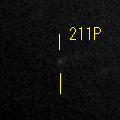
|
Now it is 17.9 mag (Feb. 20, H. Nohara). It will be fading after this, and it will be fainter than 18 mag in March. It locates somewhat low in the Southern Hemisphere.
Date(TT) R.A. (2000) Decl. Delta r Elong. m1 Best Time(A, h)
Feb. 25 11 57.77 24 56.4 1.579 2.506 154 17.8 1:41 ( 0, 80)
Mar. 4 11 53.78 26 14.8 1.584 2.523 156 17.8 1:10 ( 0, 81)
|
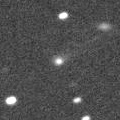
|
It brightened up to 15.9 mag in 2022 spring (May 5, Toshiyuki Takahashi). In 2023, it is observable at 17.5 mag in spring.
Date(TT) R.A. (2000) Decl. Delta r Elong. m1 Best Time(A, h)
Feb. 25 16 23.84 -23 42.6 4.793 4.855 87 17.8 5:11 (345, 30)
Mar. 4 16 26.73 -23 55.0 4.690 4.862 94 17.8 5:02 (349, 30)
|

|
Now it is 17.5 mag (Feb. 15, Toshihiko Ikemura, Hirohisa Sato). It will be fainter than 18 mag soon.
Date(TT) R.A. (2000) Decl. Delta r Elong. m1 Best Time(A, h)
Feb. 25 8 38.64 0 42.6 2.608 3.505 150 17.8 22:19 ( 0, 56)
Mar. 4 8 36.65 1 7.3 2.654 3.509 144 17.9 21:49 ( 0, 56)
|
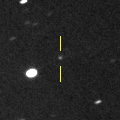
|
Now it is 18.0 mag (Feb. 16, Toshihiko Ikemura, Hirohisa Sato). It will brighten up to 15 mag from 2024 to 2025. In 2023, it is observable at 18 mag in spring.
Date(TT) R.A. (2000) Decl. Delta r Elong. m1 Best Time(A, h)
Feb. 25 9 45.24 25 49.8 3.436 4.381 160 17.9 23:25 ( 0, 81)
Mar. 4 9 40.70 26 5.7 3.460 4.369 153 17.9 22:53 ( 0, 81)
|
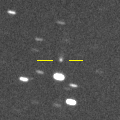
|
It was predicted to brighten up to 16 mag in 2023. But actually, it is very faint as 18.2 mag (Feb. 7, J.-C. Merlin, D. De Martin). In the Southern Hemisphere, it stays observable in good condition for a long time. In the Northern Hemisphere, it will never be observable again.
Date(TT) R.A. (2000) Decl. Delta r Elong. m1 Best Time(A, h)
Feb. 25 17 34.06 -72 6.6 3.335 3.245 76 17.9 5:11 (350,-19)
Mar. 4 18 1.57 -72 57.2 3.291 3.248 78 17.9 5:02 (350,-20)
|
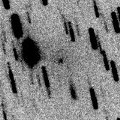
|
Tiny comet, but it approached to Sun down to 0.8 a.u. in January, and it will approach to Earth down to 0.6 a.u. in March. It was expected to brighten up to 14 mag from January to March. But actually, it became disintegrated before the perihelion passage. Now it is extremely faint as 18.2 mag (Feb. 20, Thomas Lehmann). In the Southern Hemisphere, it stays observable in good condition for a long time. It becomes observable in good condition after this also in the Northern Hemisphere.
Date(TT) R.A. (2000) Decl. Delta r Elong. m1 Best Time(A, h)
Feb. 25 3 40.43 -59 8.7 0.674 1.049 75 18.7 19:15 ( 14, -6)
Mar. 4 5 2.65 -47 38.9 0.610 1.127 86 18.7 19:21 ( 11, 7)
|
|
![]()
 402P/2020 Q3 ( LINEAR )
402P/2020 Q3 ( LINEAR ) 280P/Larsen
280P/Larsen C/2020 H6 ( ATLAS )
C/2020 H6 ( ATLAS ) C/2014 UN271 ( Bernardinelli-Bernstein )
C/2014 UN271 ( Bernardinelli-Bernstein ) C/2019 O3 ( Palomar )
C/2019 O3 ( Palomar ) P/2021 N2 ( Fuls )
P/2021 N2 ( Fuls ) 244P/Scotti
244P/Scotti C/2021 S4 ( Tsuchinshan )
C/2021 S4 ( Tsuchinshan ) C/2022 U4 ( Bok )
C/2022 U4 ( Bok ) 452P/2022 B5 ( Sheppard-Jewitt )
452P/2022 B5 ( Sheppard-Jewitt ) C/2022 W2 ( ATLAS )
C/2022 W2 ( ATLAS ) 211P/Hill
211P/Hill 99P/Kowal 1
99P/Kowal 1 P/2021 V2 ( Fuls )
P/2021 V2 ( Fuls ) 65P/Gunn
65P/Gunn C/2021 C5 ( PanSTARRS )
C/2021 C5 ( PanSTARRS ) C/2022 S3 ( PanSTARRS )
C/2022 S3 ( PanSTARRS )![]()































































